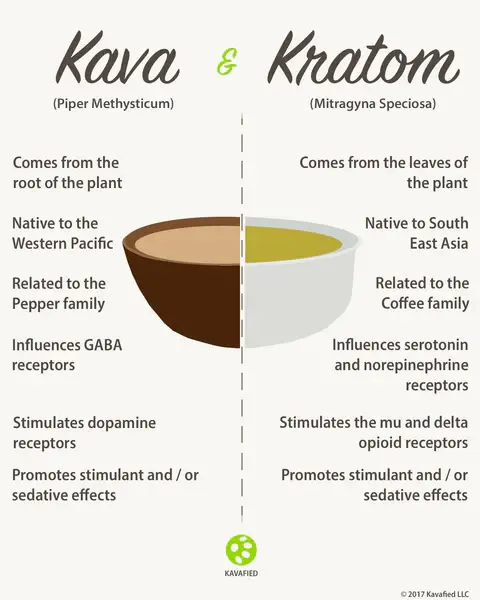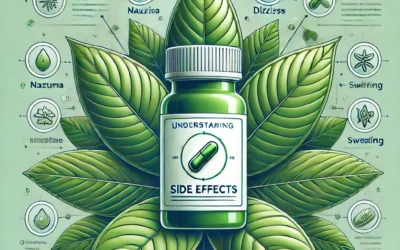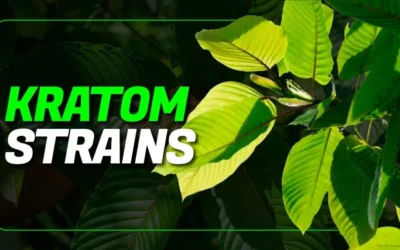What Is Kratom?
Kratom, a plant native to Southeast Asia, has gained attention and sparked curiosity among many individuals who are surprised to learn that it is actually caffeine-free. This revelation often leaves people taken aback, as kratom is closely related to coffee, a beverage known for its energizing effects. However, despite this botanical connection, kratom does not contain any caffeine.
In its countries of origin, such as Thailand, Malaysia, and Indonesia, kratom has been traditionally used by locals for centuries. The customary practice involves chewing the leaves of the kratom plant, which is believed to provide a boost of energy and vigor. This method of consumption allows the active compounds present in the leaves to be absorbed directly into the bloodstream, resulting in a energizing effect.
However, despite its long history of use and cultural significance in Southeast Asia, kratom has faced legal restrictions and prohibitions in certain countries. Concerns about potential dependency and abuse have led to its ban in some regions. Authorities worry that the stimulating properties of kratom may lead to addiction or misuse, similar to other substances that affect the central nervous system.
While kratom is not classified as a controlled substance in many countries, its legal status varies widely. Some nations have imposed strict regulations, making it illegal to possess, sell, or use kratom. In contrast, other countries have adopted a more lenient approach, allowing its sale and consumption under certain conditions or with specific regulations in place.
The debate surrounding kratom’s legality and potential risks continues to be a topic of discussion among policymakers, healthcare professionals, and the general public. Research on kratom’s effects, both positive and negative, is ongoing, with scientists striving to understand its potential benefits and risks more comprehensively.
In conclusion, the surprising fact that kratom, a plant closely related to coffee, is caffeine-free often catches people off guard. Its traditional use in Southeast Asia as a natural energy booster through leaf chewing has been overshadowed by concerns about dependency and addiction, leading to its prohibition in some countries. The legal status of kratom remains a complex and evolving issue, with ongoing research aiming to shed more light on its effects and potential benefits.
However, Thailand has since changed their minds and now permit mitragyna speciosa to be grown and exported for medicinal uses.
Kratom tea is still exported worldwide. Manufacturers grind the leaves and prepare them for sale as a dietary supplement or tea.
US customers buy kratom as powder, liquid extract, or capsules. Powder is commonly made into tea or stirred into drinks, while capsules are favored for their intense flavor.
What Is kava?
Piper Methysticum is derived from the roots of the pepper family plant, native to Fiji and Indonesia. It is used to make different types of tea and juices. In restaurants and bars, it is mixed with either water or coconut milk to create drinks for social or recreational purposes. Additionally, it has a ceremonial role.
Kava piper methysticum, also known as kava, is a plant native to the South Pacific islands. It has been used for centuries by the indigenous people of these islands for its medicinal and ceremonial purposes. Kava is primarily consumed as a tea, made from the roots of the plant.
The preparation of kava tea involves grinding the roots into a fine powder, which is then mixed with water. The mixture is traditionally strained through a cloth to remove any coarse particles, resulting in a smooth and earthy-tasting beverage. Kava tea is often consumed in social gatherings and cultural ceremonies, where it is believed to promote relaxation, enhance sociability, and induce a sense of calmness.
Kava tea contains several active compounds, known as kavalactones, which are responsible for its effects.
In addition to its calming properties, kava tea is also known for its potential benefits. It has been suggested that kava may have diuretic properties.
However, it is important to note that the consumption of kava tea is not without risks. Using excessive kava for extended periods may damage the liver, leading to bans or restrictions on kava products in certain nations.
It is recommended to drink kava tea in moderation. It is also advised to consult with a doctor before incorporating it into your daily routine. This is especially important if you have liver issues or if you are taking medications that may interact with kava.
Overall, kava piper methysticum, or kava tea, is a popular beverage known for its calming effects and potential benefits. While it has a long history of traditional use, it is essential to approach its consumption with caution and awareness of potential risks. Kava is a popular plant-based remedy in the United States, consumed in the form of tea, supplements, or even as an ingredient in certain baked goods.
Kava vs Kratom
Kratom and Kava are two distinct substances that share some similarities but also have significant differences. Firstly, they belong to different plant families. Kratom is derived from the Mitragyna speciosa tree, which is native to Southeast Asia, while Kava is made from the roots of the Piper methysticum plant, found in the South Pacific islands.
One of the most notable distinctions between Kratom and Kava lies in the effects they produce. Kratom is known for its stimulating properties, similar to those of coffee. It contains alkaloids that interact with the brain’s receptors, resulting in increased energy, focus, and alertness. Many individuals use Kratom as a natural alternative to coffee or other stimulants.
On the other hand, Kava root is primarily used for relaxation and stress relief. It contains compounds called kavalactones, which have sedative and anxiolytic effects. When consumed, Kava induces a sense of calmness and tranquility. It is often used as a social beverage in traditional ceremonies or as a way to unwind after a long day.
Furthermore, the methods of consumption for Kratom and Kava differ. Kratom is commonly ingested by chewing the leaves, brewing them into a tea, or consuming it in powder or capsule form. It is also available in various strains, each with its own unique effects and potency.
In contrast, Kava is typically prepared by grinding the root into a powder, which is then mixed with water to create a thick, muddy beverage. This mixture is often strained to remove any coarse particles before consumption. Traditional Kava preparation involves a ceremonial process, where the beverage is shared among participants to promote a sense of community and relaxation.
In summary, while Kratom and Kava may share some similarities, such as being derived from plants and having potential calming effects, they differ significantly in their plant origins, effects, and methods of consumption. Kratom is commonly used as an energy booster, similar to coffee, while Kava root is primarily sought after for its relaxation properties. Understanding these distinctions is crucial when considering the use of either substance.
Kratom’s effects are connected to strain. For example, Bali induces relaxation, while Maeng Da has an energetic effect. Dosage is essential; lower dosages yield energizing effects like coffee, while greater dosages produce relaxation. Additionally, speciosa has mood-boosting effects.
Kava’s effects are often used to help sleep or relax. Additionally, it can influence one’s mood by acting on the brain’s emotion-related region.
Kratom and kava, plant-based supplements, are taken for their calming and mood-enhancing properties. They can be found in various forms, such as raw leaves, and although their effects are alike, they come from distinct plants and act differently.
Is Kratom and Kava legal?
Legality of kratom depends on location. DEA classifies it as a “drug of concern,” so individual states and counties make decisions on kratom legality. As of Oct. 2019, 6 states have prohibited it, 5 have limited it to certain counties, and more have pending legislation. In locations where it is allowed, kratom is typically bought in tobacco shops, specialty stores, or through the internet.
Kava and kratom are both legal substances in all states across the United States. However, while kava has not faced much controversy, kratom has been a topic of debate and scrutiny. The reason for this difference in perception lies in the fact that kava has a longer history of being consumed and documented in the food supply prior to the passing of the Dietary Supplement Health and Education Act (DSHEA Act).
Kava, a plant native to the South Pacific, has been used for centuries by Pacific Island cultures for its relaxing and calming effects. It has been traditionally consumed as a ceremonial drink and is deeply ingrained in the cultural practices of these communities. Due to its long-standing use and acceptance, kava has been recognized as a safe and legal substance in the United States.
On the other hand, kratom, a tropical tree native to Southeast Asia, has gained attention and controversy in recent years. Kratom leaves contain compounds that can have energizing or relaxing effects, and it has been used traditionally in Southeast Asian countries for its properties. However, its use and legality in the United States have been more contentious.
The DSHEA Act, passed in 1994, regulates dietary supplements and their ingredients. It requires that manufacturers ensure the safety of their products and provide accurate labeling. However, at the time of the act’s passing, kava had already been documented and recognized as a safe food ingredient, which exempted it from the same level of scrutiny as kratom.
Kratom, on the other hand, did not have the same historical documentation and recognition as kava. As a result, it has faced more scrutiny and regulation in the United States. Some states have even banned the sale and possession of kratom due to concerns about its potential for abuse and adverse health effects.
In conclusion, while both kava and kratom are legal substances in all states in the United States, kava has not faced the same level of controversy as kratom. This is primarily due to kava’s longer history of use and documentation in the food supply before the passing of the DSHEA Act. However, it is important to note that the legal status and perception of these substances may vary from state to state, and individuals should always research and understand the laws and regulations in their specific jurisdiction.
Kava is sold in specialty stores as well as more mainstream stores, including grocery stores, pharmacies and other food and beverage stores.
Kratom and Kava
Kratom and Kava are both natural plants, but they bring different effects. The DEA and FDA have been examining kratom due to safety worries. An updated 8-factor analysis has shown that the addicition potential for kratom is very low, but dependance is possible.
Debate over kratom-related overdoses continues; a CDC study of 27,000 fatalities showed 91 deaths due to kratom, more than double the FDA’s earlier statistics, but most were ruled out as poly drug interactions. Overdose risk increases when people take cheap kratom with other illicit drugs. Additionally, no FDA regulation means no purity guarantee.
The risks of Kratom may include:
- Dependency: Heavy, frequent, and prolonged use of Kratom can lead to dependency in some individuals.
- Gastrointestinal Issues: Kratom can cause nausea, constipation, and stomach discomfort, especially with high doses or frequent use.
- Interactions with Medications: Kratom may interact with certain medications, leading to potential adverse effects or reducing their efficacy.
- Pregnancy: Pregnant and nursing women are generally advised to avoid Kratom due to its potential effects on the developing fetus or infant.
- Liver Toxicity: There have been cases of liver toxicity associated with Kratom use, although it’s relatively rare.
- Contamination: Contaminated or adulterated Kratom products can pose additional health risks.
- Legal Status: Kratom’s legal status varies by country, state, or region, and its possession may be restricted or banned in some areas.
Using Kratom responsibly is important. Follow recommended dosages and consult a healthcare professional if you have health concerns or take medications. Additionally, purchasing Kratom from reputable vendors ensures product quality and safety.
Risks of Kava May Include:
- Liver Toxicity: Prolonged or excessive use of Kava has been linked to potential liver problems in some individuals.
- Drowsiness: Kava can cause drowsiness and impair cognitive and motor skills, so it’s advised not to drive or operate machinery after consumption.
- Interaction with Medications: Kava may interact with certain medications, so it’s essential to consult with a healthcare professional before using it.
- Allergic Reactions: Some people may experience allergic reactions to Kava, resulting in skin rashes or other symptoms.
- Pregnancy and Nursing: Pregnant and nursing women are generally advised to avoid Kava due to its potential effects on the developing fetus or infant.
- Heavy Use: Heavy and frequent use of Kava may lead to tolerance and dependence.
Use Kava responsibly and in moderation. Consult a healthcare professional if you have health concerns or take medications. Also, check the legal status of Kava in your area, as it may be restricted or banned.
Herbal Interactions
Mixing prescription medications with herbal substances can potentially have harmful effects on your health. While herbs are often considered natural and safe, they can still interact with medications and cause adverse reactions. It is crucial to consult with your doctor or healthcare provider before incorporating any new herbs into your daily routine.
Prescription medications are carefully prescribed by healthcare professionals to treat specific medical conditions. They are formulated with specific dosages and combinations of active ingredients to ensure their effectiveness and safety. However, when herbal substances are introduced into the mix, the chemical composition of the medications can be altered, leading to unpredictable outcomes.
Herbs, on the other hand, contain various compounds that can have medicinal properties. They are often used as alternative or complementary treatments for various ailments. However, these natural substances can also have potent effects on the body, and their interactions with prescription medications can be unpredictable.
Certain herbs can interfere with the absorption, metabolism, or elimination of prescription drugs, affecting their efficacy or increasing the risk of side effects. For example, some herbs may inhibit the enzymes responsible for breaking down medications in the liver, leading to higher drug concentrations in the body. This can potentially result in toxicity or overdose.
Additionally, herbs can have similar therapeutic effects as certain medications, leading to an excessive or redundant treatment. This can put unnecessary strain on your body and potentially worsen your condition. For instance, combining blood-thinning medications with herbs that have anticoagulant properties can increase the risk of bleeding.
Furthermore, some herbs may have sedative or stimulant effects, which can interact with medications that have similar properties. This can lead to excessive drowsiness or agitation, compromising your ability to function normally.
To ensure your safety and optimize the effectiveness of your medications, it is crucial to have open and honest communication with your doctor or healthcare provider. They have the expertise to assess your medical history, current medications, and potential herb-drug interactions. They can provide personalized advice and guidance on whether it is safe to incorporate specific herbs into your daily routine.
Remember, your doctor or healthcare provider is the best source of information when it comes to your health. They can help you make informed decisions about your treatment plan and ensure that any additions to your routine are safe and beneficial. So, before considering any new herbs, always consult with your healthcare professional to avoid any potential risks or complications.
Conclusion
Kratom’s and Kava’s risk of addiction is related to its use for relaxation and the effect it has on the brain. Feeling relaxed is an important factor in addiction, as some people may depend on the emotion it evokes.
Kratom Addiction and Kava addiction are still being studied, but these “addictions” seem to more along the lines of Coffee addiction.
Individuals with a history of substance misuse are more likely to become dependant. Using it frequently, especially in high doses or using extracts, increases the probability of dependency. People can be dependant upon anything and the real disease of addcition is what has to be addressed before true healing and change can occur.






0 Comments